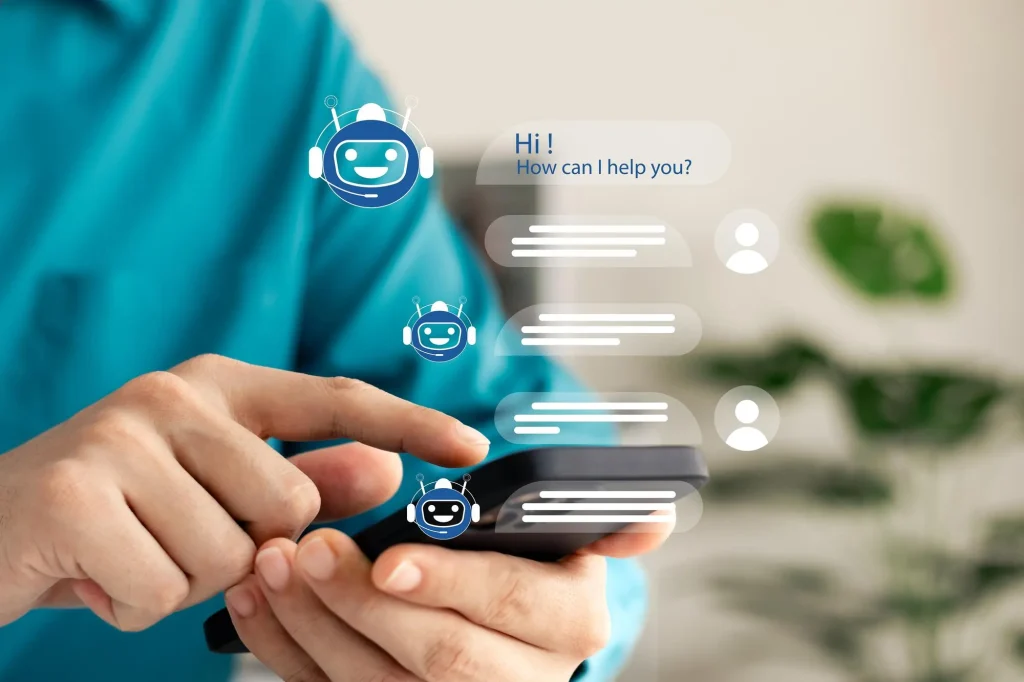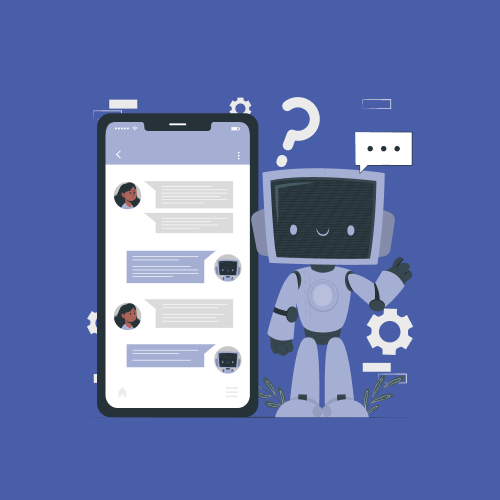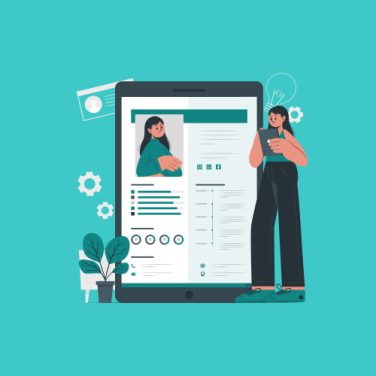HR chatbots are AI-powered virtual assistants specifically designed for human resources tasks.
Leveraging natural language processing and machine learning, these chatbots can handle various HR functions, such as answering frequently asked questions, aiding in recruitment processes, and assisting with onboarding activities.
They automate routine tasks, providing prompt responses and freeing HR professionals to focus on strategic initiatives, thereby improving productivity and employee satisfaction.
As businesses strive for efficiency, HR chatbots are becoming essential tools, transforming how traditional HR operations are conducted.
The evolution of chatbots in HR

The concept of chatbots in HR is evolving rapidly.
Initially, chatbots were simple rule-based programmes responding to specific commands. However, with advancements in AI, today’s HR chatbots are becoming more sophisticated and versatile. They can prequalify candidates, facilitate document submission processes, and even gather employee feedback.
AI’s role in transforming HR functions is multifaceted. By integrating HR chatbots, businesses have access to real-time data and insights, which enhances decision-making capabilities. The integration of HR analytics not only aids in efficient workforce management but also ensures compliance with regulations, providing a strategic edge to organisations.
Moreover, as HR departments become more data-driven, chatbots have proven invaluable. For example, the MiHCM suite offers integrated HR chatbot solutions, helping businesses utilise data-driven insights for smarter HR decisions. This capability supports HR professionals in managing their workforce effectively and proactively addressing challenges as they arise.
Benefits of using HR chatbots
HR chatbots, as AI-driven assistants, bring a wave of efficiency and empowerment to various HR processes. By automating repetitive and mundane tasks, these chatbots facilitate quicker responses to employee inquiries, allowing HR professionals more time to focus on strategic decision-making and developing innovative HR strategies.
Key benefits of integrating HR chatbots include:
- Improved efficiency: By managing routine inquiries and tasks, chatbots streamline operations and free HR teams for more complex issues.
- Enhanced employee engagement: Chatbots can personalise employee interactions, boosting satisfaction and ensuring employees feel heard and supported.
- Cost savings: Automating routine HR tasks leads to significant budget reductions, as less human intervention is required.
- Accurate decision-making: With real-time data provided by chatbots, HR departments can make informed decisions based on current insights.
Real-world use cases
HR chatbots are revolutionising various HR functions, including recruitment, onboarding, and continuous employee support. Here are some significant use cases:
- Recruitment: Automating the early stages of the recruitment process, such as resume screening and interview scheduling, allows HR teams to concentrate on candidate assessment and selection.
- Onboarding: New hire integration is smoother with chatbots, which guide them through company policies, cultural norms, and even collect the necessary documentation.
- Employee support: Offering 24/7 support, HR chatbots can instantly provide answers to common HR questions and help with tasks such as vacation requests, all without human intervention.
Addressing common challenges
Despite their numerous advantages, implementing HR chatbots does come with certain challenges. Some of the prominent issues include:
- Integration complexities: Ensuring a smooth integration with existing HR systems requires a comprehensive understanding of API options and thoughtful planning to align with business workflows.
- Data security and privacy concerns: As chatbots handle sensitive employee data, ensuring compliance with privacy regulations like GDPR is crucial for maintaining employee trust.
- Limited capabilities: While HR chatbots are advanced, they might struggle with complex inquiries requiring human empathy and understanding.
- Technical glitches: Like any technology solution, chatbots can experience downtime or face technical issues that temporarily hinder HR operations.
To overcome these challenges, it’s critical to conduct thorough pre-implementation planning, including running beta tests to identify potential roadblocks, and to ensure continuous monitoring and updates.
A transformative step for organisations

The integration of HR chatbots with existing systems is a transformative step for organisations, facilitating seamless workflow automation and enhancing overall efficiency.
This section delves into the essential aspects of integrating chatbots into your HR infrastructure, ensuring a harmonious transition that ties together technology and human oversight.
- Assessment of current systems: Start by evaluating your current HR systems and processes. Understand the existing workflow to determine the areas where HR chatbots can add the most value. This assessment is crucial to identify compatibility and integration points.
- Selecting the right chatbot platform: Choosing the appropriate platform is essential for successful integration. Consider platforms like MiHCM Suite, which offers comprehensive solutions tailored to various HR functions, enhancing data-driven decisions and simplifying HR operations.
- API options and technical readiness: Integration requires technical readiness, especially API compatibility. Ensure that the chosen chatbot platform provides robust API options that align with your current HR software, such as payroll or attendance systems. This will allow for smooth data exchange and operation continuity.
- Data compliance and security: One of the major considerations is ensuring that the integration complies with data protection regulations. Safeguarding sensitive employee information should be a priority, necessitating compliance with standards to maintain trust and confidence.
- Testing and validation: Prior to full-scale implementation, conduct extensive testing to validate the chatbot’s functionalities within your HR systems. Use beta testing to iron out potential issues and ensure that the chatbot behaves as expected in real-world scenarios.
- Employee training and change management: With new technology, training is vital. Educating staff on chatbot interactions and functionalities ensures that they are equipped to engage optimally with the system. Change management strategies can aid in a smooth transition and reduce resistance.
Technical and compliance considerations
Technical integration is just one part of the puzzle; regulatory considerations are equally important. With the advent of sophisticated HR AI chatbots, it is imperative to address these considerations comprehensively.
- IT infrastructure: Make sure your IT infrastructure can support the additional load and the data exchange processes required by the chatbot services. This might involve upgrading existing systems or investing in new server capacities.
- Data privacy protocols: Establish and enforce stringent data privacy protocols that align with existing legal frameworks. Secure and encrypt sensitive information to prevent data breaches and unauthorised access.
- Legal compliance: Stay abreast of legal requirements concerning AI and chatbot usage. Regular audits and updates to your security policies ensure continued compliance with evolving regulations.
- Continual improvement and feedback mechanism: Post-integration, continue to gather feedback and insights to refine your chatbot’s functionality. An iterative improvement approach will help in adapting to changing needs and improving chatbot performance over time.
By meticulously tackling these aspects, businesses can successfully integrate human resource chatbots, resulting in streamlined workflows, enhanced employee self-service, and superior HR chatbot benefits.
This integration not only empowers employees with efficient HR requests and approvals but also fortifies the organisation’s position in achieving cost savings and operational excellence.
Trends shaping the future of HR chatbots
As we advance further into the digital age, the role of chatbots in HR continues to grow and adapt, driven by emerging technologies and shifting business needs.
One of the key trends is the increased personalisation and contextual understanding of chatbots, enabled by advanced machine learning algorithms. These smart systems are increasingly capable of analysing employee interactions to tailor responses that are more relevant and insightful.
Another major trend is the integration of chatbots with sophisticated HR analytics platforms. By connecting conversational AI with human resource chatbots, companies can use real-time data to make informed HR decisions, predict employee needs, and tailor services accordingly.
This fosters a more proactive approach to human resources, ensuring that employee concerns are addressed before they escalate.
Additionally, HR chatbots are expected to play a crucial role in remote workforce management. With the rise of remote and hybrid work models, chatbots help maintain employee engagement and oversee daily activities through seamless digital communication and automated task management.
This reflects the evolving expectations for a more connected and efficient workplace environment.
Case studies of successful implementations
Several organisations have already unlocked the potential of integrated HR chatbot solutions, achieving remarkable results. Let’s explore some notable cases:
- Ubisoft: By deploying Eightfold AI, Ubisoft enhanced its internal talent management. The bot facilitated better candidate matching and streamlined recruiting processes, leading to a significant decrease in hiring time.
- Globe Telecom: Leena AI was introduced to speed up ticket resolution times, greatly improving operational efficiency and employee satisfaction. Globe Telecom’s HR team could allocate resources more efficiently, focusing on strategic projects.
- Honest Burgers: The Bot Platform was leveraged to automate repetitive tasks and manage customer and employee communications seamlessly. This led to improved engagement and operational agility.
- National Safety Apparel: Using Hirevue, this apparel company automated significant parts of its hiring process, reducing both time and costs while maintaining a high-quality candidate experience.
These examples highlight how a chatbot for employees can transform HR operations, providing tangible benefits in operation efficiency and employee satisfaction.
Impact on HR efficiency and business performance
The influence of HR AI chatbots extends beyond just improving HR processes; they have the power to catalyse overall business performance.
Businesses that have integrated chatbots witness increased efficiency due to automation of routine tasks like interview scheduling, candidate screening, and document processing. This not only frees up HR professionals to focus on more critical, strategic tasks but also ensures a swift and consistent employee experience.
By reducing processing time and minimising human error, chatbots enable firms to achieve significant cost savings, directly impacting the bottom line. Furthermore, their ability to handle a large volume of queries without fatigue improves service consistency and reliability, enhancing company reputation.
Organisations adopting these technologies are seeing a boost in both employee retention and productivity, illustrating the confluence of technology and human resource management in modern businesses.
As technology continues to evolve, chatbots are poised to play even greater roles in the HR landscape, cementing their place as indispensable tools for optimising business workflows and engagement strategies.
Measuring the ROI of HR chatbots
Implementing chatbot in HR strategies is becoming more common as businesses recognise the potential for significant returns on investment (ROI). Measuring this return, however, involves multiple metrics.
Firstly, consider time savings. HR chatbots automate routine tasks like candidate pre-screening and FAQ handling, which can drastically reduce time spent on these functions.
Cost efficiency plays another crucial role in determining ROI. By minimising the need for extensive HR personnel devoted exclusively to administrative tasks, businesses see direct reductions in labour costs.
Furthermore, the enhancement in employee engagement can lead to increased productivity and employee satisfaction. This can be difficult to quantify but greatly affects overall business performance.
Technical considerations in chatbot deployment

Data security is paramount. Chatbots manage sensitive employee information, necessitating robust compliance with regulations like GDPR. Businesses must ensure this data is protected against breaches.
When considering integration with existing HR systems, businesses should evaluate technical compatibility. Solutions like the MiHCM Suite offer seamless integration capabilities that enhance HR operations through data-driven insights and efficient workflows, aligning chatbot functionality with current systems effectively.
Adequate API support is essential to facilitate smooth data flow between human resource chatbot frameworks and HR software, ensuring reliable and efficient performance.
- IT infrastructure: Ensure your IT framework can support chatbot operations without disruption.
- Vendor selection: Select reputable providers to mitigate risks associated with data management and system compatibility.
Engaging in a comprehensive pilot testing phase can help identify potential bugs and integration obstacles before full deployment, ensuring a successful chatbot launch.



